
How to Attract More Butterflies to Your Garden or Balcony
Fluttering butterflies in gardens and on balconies are becoming rarer. Never before have so few been spotted as during last weekend’s Butterfly Count. But enthusiasts can lend a hand to the butterfly population and the sharply reduced biodiversity.
Creating a Butterfly-Friendly Environment
Those who want to can make their gardens or roof terraces more attractive to insects. “All gardens together are a large area,” says Koos Biesmeijer of the Dutch Biodiversity and Society research group at Naturalis. They are important habitats for animals, he explains, partly because “large parts of the agricultural area are actually a kind of desert. And that’s another insult to the desert.”
After decades of intensive farming and ranching, the Netherlands is a champion of biodiversity loss. Of course, this problem is not solved simply by greening your backyard, acknowledges Kars Veling of the Butterfly Foundation. Nevertheless, “it absolutely makes sense. And a lot of measures for more butterflies also work out positively for other insects.”
Choosing the Right Plants
Not every plant you buy in a garden center promotes biodiversity. Veling and Biesmeijer advise people to buy as many flowers, shrubs, and trees as possible that have been grown organically, or in other words, not sprayed with pesticides.
How harmful these chemicals are to plants and animals depends on the type of pesticide and the dosage. “Systemic pesticides, for example, are spread throughout the plant,” Biesmeijer says. “If a caterpillar eats from that or if a butterfly drinks the nectar, it will have an effect. Those substances are made to kill insects.” Through birds that eat the insects, the drug can then enter the rest of the food chain.
According to the two experts, the unsprayed supply in garden centers is now limited. “It is also often a bit more expensive,” explains butterfly expert Veling. He hopes that the demand for organically grown plants will increase so that the supply will also follow.
Mowing and Pruning Practices
In general, the more varied the supply of plants, the more species will feel at home somewhere. Veling also recommends mowing less and pruning in stages. “Try not to do everything at once, but leave bits and pieces,” he says. Insects then have a place to hide.
The same goes for winterizing the garden. “Some people remove almost everything that sticks out above the ground, but there are still all the eggs of caterpillars in there,” he says. He urges people not to throw the remains in the green bin right away and leave a little more. That doesn’t fit the classic image of a tightly raked garden, “but you have to do something for biodiversity.”
Understanding Biodiversity
Biodiversity stands for all types of animals, plants, and microorganisms on Earth. They form a network of which humans are a part. The loss of species can have unforeseen consequences on the balance of ecosystems. “Butterflies have intrinsic value and are an important part of the system,” says Veling. “If you have a nesting box, you see how often birds fly off and on with caterpillars as food. In addition, the butterfly is a mascot for insects because they are eye-catching and many people love them.”
The two experts urge people not to use pesticides in their gardens. “It’s actually a no-brainer, but such pesticides are sold a lot,” said Biesmeijer, who is also a professor of Natural and Capital at Leiden University.
Encouraging Native Plants
Those who want more insects and animal species are better off leaving spontaneously emerging plants in place. Biesmeijer: “The species that fall under the heading of weeds often have the most value for biodiversity.” For example, several butterfly species depend on nettles, which are eaten by caterpillars.
Hydrangeas: A Misleading Choice
A hydrangea may seem like the ideal plant for a butterfly. Yet it certainly is not, the professor explains. “The large flowers of a hydrangea are grown to the point where they no longer contain pollen or nectar. We can like it or not, but they are worthless for biodiversity.”
Caterpillars like to eat plants native to the Netherlands. Once out of their cocoons, Biesmeijer says they are just as happy as butterflies to get nectar from exotic species. “Butterfly bushes, for example, are not native but are very good for butterflies, as long as they are unsprayed,” he emphasizes.
By adopting these practices and choosing the right plants, gardeners can play a significant role in supporting butterfly populations and enhancing biodiversity in their own backyards.

